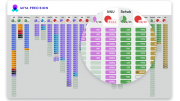Health and social care secretary Sajid Javid has announced a new target to complete the digitisation of the acute sector. The Highland Marketing advisory board discussed the approach being developed by NHS England’s transformation directorate, and the challenges to making it work.
In the first week of February, the Health Service Journal reported that it had seen a PowerPoint presentation of the digital plans being drawn-up by NHS England’s transformation directorate, which is absorbing NHSX and NHS Digital.
The magazine revealed that the directorate wants to see the “universal adoption of electronic patient records” as part of its “foundational vision” and that it wants clinical decision support to become “the norm” for all clinicians.
Just a few weeks later, health and social care secretary Sajid Javid told the HSJ digital transformation summit that he is setting new targets for the adoption of EPRs in England. He said he wants 90% of trusts to be at Level 5 on the HIMSS EMRAM maturity model by December 2023, with the other 10% well on the way to deploying an EPR.
A shift in NHS digital policy
This is a significant shift in focus. The Highland Marketing advisory board held a debate on the future of EPRs last year, because it felt as though NHSX wasn’t particularly interested in completing the digitisation of hospitals.
Yet there have been signs that something like this announcement has been coming. In retrospect, the most significant move was made last March, when NHS England announced that it was making Tim Ferris its director of transformation.
Ferris used to lead the Massachusetts General Physicians Organisation, which in 2016 agreed a $1.2 billion deal for Epic. In October, digitalhealth.net reported that Ferris had been suggesting an even bigger deal: a contract with Epic for a single, national EPR for the entire NHS.
While that was always unlikely, NHSX went on to announce a reboot for the digital aspirant programme that was interesting in two ways. First, Digital Aspirant Plus or DA+ focused on EPRs, and not on the departmental, e-obs, and AI systems that have received digital aspirant funding in recent years.
Second, DA+ comes with central support to procure an EPR and ‘buddying’ support to deploy one. At one level, this looked like a bid to learn the lessons of the global digital exemplar programme, which the National Audit Office has judged a success.
On another, it looked like a bid to give the centre more control over the systems being chosen. Shortly after HSJ reported on Javid’s target, it reported that NHS England has been sending out forms asking integrated care systems about their plans to ‘converge’ local EPRs.
So, twenty years after the National Programme for IT was launched, it looks as though the Department of Health and Social Care and NHS England are going to have another go at getting EPRs into every trust, and that they want to do some market shaping in the process.
How much ‘convergence’?
When the Highland Marketing advisory board met towards the end of February, members debated whether the push would work, and the pros and cons of ‘convergence’.
Chair Jeremy Nettle suggested that it looked as though the centre would still like to see Epic everywhere. “The way things are forming up, with the integration of NHSE, X, and D, and the latest announcements, it looks like they’d like a Henry Ford offer: you can have any colour of EPR you like, as long as it’s black!”
However, the reality on the ground is that the landscape is too messy for this to happen. Nicola Haywood-Alexander, system chief information officer at NHS Lincolnshire, pointed out that EPRs are only used by acute trusts; mental health and community providers have their own systems, as do GPs, and they’re not going to rip them up and take them out.
“We’re all discussing what the definition of ‘convergence’ is going to be, and the utopian answer might be ‘one system’ across an ICS, but the pragmatic answer is going to be ‘data’ and systems that allow data to be exchanged with each other,” she said.
Even in the acute sector, trusts that have achieved a high level of digitisation using a mix of single supplier EPRs and other systems, or ‘best of breed’ approaches, are also unlikely to undo the work they have done. But for the large minority of trusts that are still mostly paper-based, adopting the EPR or approach of another member of an acute group, a neighbour, or the majority of trusts in its ICS area, should make sense.
Andy Kinnear, who retired from the NHS after 30-years and now works for Ethical Consulting, said: “In some areas, trusts have been deliberately difficult with their EPR choices. We can all think of cities in which there are three or four trusts and they’ve refused to use a single instance of an EPR, because they think it will make it harder to merge them.
“Any attempt to tackle that kind of behaviour is going to be a good thing, so we can get on with sharing data to do what we’re meant to be doing, which is creating better services for patients.”
The challenges: deployment
If Whitehall and NHS England do use DA+ and the new EPR target to encourage acute trusts to ‘converge’ on systems at an acute group or ICS level, the NHS will end up with a smaller number of single-system suppliers.
As Matthew Swindells pointed out in a recent Highland Marketing interview, that was one of the intentions of the GDE programme, so recent developments can be seen as taking the health service back to where it was before NHSX arrived on the scene. However, Kinnear pointed out that it won’t be enough to guarantee that NHS trusts will be at HIMSS 5 on target.
“We shouldn’t underestimate how hard it is to deploy,” he said. “Fewer products will make your provider landscape a lot more manageable, but it doesn’t make your trust landscape more manageable. Every trust will have its own way of doing booking, or managing transfers from A&E or whatever, and you have to get into all of that.”
Time and leadership
The advisory board identified two additional challenges to getting the 20% of trusts that are still mostly paper-based over the line: timescales and leadership. As Kinnear pointed out: “No matter how many times we’ve tried to do this in England, we’ve failed, and one reason is that we keep announcing new approaches and failing to see them through.
“As soon as it gets tough, we change the national leadership and start again. I think that if we’d stuck with the NPfIT – ok, perhaps not NPfIT, but certainly the GDE programme – we’d be there by now.
“I remember talking to the leaders of the GDE programme when it launched [in 2016], and they said: ‘The Treasury won’t give us the money to put EPRs into the entire NHS, because it doesn’t think we’ll manage to deploy. So, we’re going to do a few trusts, to prove that we can do it, and then we’ll go back to the Treasury, and ask for the millions and millions required.
“And they were going along, but then Matt Hancock arrived [as health and social care secretary] and it all changed [as Hancock set up NHSX]. Every IT programme seems to last about three years, but it takes a year to get the programme together, and a year to do the procurement, and at least two years to deploy: so we never see things given enough time to get the job done.”
Targets, money, action?
On the leadership front, the board noted that NHS IT programmes tend to coincide with NHS reorganisations; and NHS reorganisations inevitably end up with good, experienced people leaving the service.
Haywood-Alexander said there are signs that this is happening now, as acute trusts form acute groups or integrated service providers and clinical commissioning groups make way for ICSs, but neither put chief information officers on their boards.
“We all spend a lot of time dealing with the system, and if you’re doing it from a position in which you feel you’re not being valued, it’s very tough,” she said. Again, Kinnear agreed: “I used to work for a shared care record, and I got put into a commissioning support unit [when primary care trusts were abolished in order to set up CCGs].
“But lots of people just gave up and left the NHS at that point, and that contributed to CCGs having a very difficult birth. They just didn’t have the leaders and the experts that they needed to be successful. And now we’re seeing the same thing happening again.”
Entrepreneur Ravi Kumar said this was a real worry. “At the start of the Covid pandemic, there was real progress on IT, and we all hoped that it would be maintained,” he said. “Instead, there seems to be a gap at the top.
“Sajid Javid and Tim Ferris are saying some interesting things, but I wonder if they always agree with each other. Even if they do it will take time for the new relationships between the Department [of Health and Social Care] and NHS England the new transformation directorate to bed in.
“It’s important to have a consistent message, but it looks like we might not get one for twelve months. While that happens, more people will leave the frontline. That’s bad, because all the good things we saw being done during Covid was done by strong people with the drive to make it happen.”
Déjà vu all over again
Nettle drew some positive conclusions from the discussion. Yes, he said, “there is an element of déjà vu about these proposals” but the hope has to be that the NHS’ central bodies, local IT leaders and industry have learned from what has gone before.
If nothing else, he pointed out, in the 20 years since NPfIT was launched, there has been widespread buy-in to the idea that technology matters. “Both healthcare providers and industry have learned so much over two decades, and there is a genuine commitment to the idea that delivering healthcare is dependent on sharing good quality and timely data with those who need it to make operational and clinical decisions.”
However, Kumar summed up some of the board’s concerns about whether current politics and organisational changes could still derail the latest attempt to digitise the NHS. “The danger is we could end up in a situation where there is a target, and money, but there isn’t the strong leadership to make it happen,” he said.
 Highland Marketing’s advisory board: Jeremy Nettle, former global advisor for Health Sciences, Oracle Corporation; Cindy Fedell, former chief digital and information officer at Bradford Teaching Hospitals NHS Foundation Trust; Andy Kinnear, former director of digital transformation at NHS South, Central and West Commissioning Support Unit; James Norman, healthcare CIO, EMEA, at DellEMC; Ravi Kumar, health tech entrepreneur and chair of ZANEC, and Rizwan Malik, divisional medical director of Bolton NHS Foundation Trust and managing director of South Manchester Radiology
Highland Marketing’s advisory board: Jeremy Nettle, former global advisor for Health Sciences, Oracle Corporation; Cindy Fedell, former chief digital and information officer at Bradford Teaching Hospitals NHS Foundation Trust; Andy Kinnear, former director of digital transformation at NHS South, Central and West Commissioning Support Unit; James Norman, healthcare CIO, EMEA, at DellEMC; Ravi Kumar, health tech entrepreneur and chair of ZANEC, and Rizwan Malik, divisional medical director of Bolton NHS Foundation Trust and managing director of South Manchester Radiology
Highland Marketing is an integrated communications, PR and marketing consultancy with an unrivalled reputation for supporting UK and international health tech companies and healthcare providers, built over almost 20 years. Read more analysis and interviews on the Highland Marketing website, follow us on Twitter @Highlandmarketng, or get in touch on: info@highland-marketing.com





